Wire Electrical Discharge Machining, Mechanical and Tribological Performance of TiN Reinforced Multiscale SiAlON Ceramic Composites Fabricated by Spark Plasma Sintering
Abstract
1. Introduction
2. Materials and Methods
2.1. Composites Production
2.2. Microstructural and Mechanical Characterization
2.3. Tribological Behavior
2.4. Electrical Properties and Wire-Electroerosion Machining (WEDM)
3. Results and Discussion
4. Conclusions
Author Contributions
Funding
Acknowledgments
Conflicts of Interest
References
- Riley, F.L. Silicon nitride and related materials. J. Am. Ceram. Soc. 2000, 83, 245–265. [Google Scholar] [CrossRef]
- Klemm, H. Silicon Nitride for High-Temperature Applications. J. Am. Ceram. Soc. 2010, 93, 1501–1522. [Google Scholar] [CrossRef]
- Shen, Z.; Zhao, Z.; Peng, H.; Nygren, M. Formation of tough interlocking microstructures in silicon nitrideceramics by dynamic ripening. Nature 2002, 417, 266–269. [Google Scholar] [CrossRef] [PubMed]
- Petzow, G.; Herrmann, M. Silicon nitride ceramics. In High Performance Non-Oxide Ceramics II; Springer: Berlin/Heidelberg, Germany, 2002; pp. 47–167. [Google Scholar]
- Lange, F.; Falk, l.; Davis, B. Structural ceramics based on Si3N4–ZrO2 (+Y2O3) compositions. J. Mater. Res. 1987, 2, 66–76. [Google Scholar] [CrossRef]
- Namini, A.S.; Gogani, S.N.S.; Asl, M.S.; Farhadi, K.; Kakroudi, M.G.; Mohammadzadeh, A. Microstructural development and mechanical properties of hot pressed SiC reinforced TiB2 based composite. Int. J. Refract. Met. Hard Mater. 2015, 51, 169–179. [Google Scholar] [CrossRef]
- Puchy, V.; Hvizdos, P.; Ivor, M.; Medved, D.; Hnatko, M.; Kovalcikova, A.; Sedlak, R.; Dusza, J. Preparation, friction, wear, and fracture of the Si3N4-Ag-GNPs composites prepared by SPS. J. Eur. Ceram. Soc. 2020, 14, 4853–4859. [Google Scholar] [CrossRef]
- Smirnov, A.; Bartolome, J.F.; Kurland, H.D.; Grabow, J.; Muller, F.A. Design of a new zirconia-alumina-Ta micro-nanocomposite with unique mechanical properties. J. Am. Ceram. Soc. 2016, 99, 3205–3209. [Google Scholar] [CrossRef]
- Grigoriev, S.; Peretyagin, P.; Smirnov, A.; Solis, W.; Diaz, L.A.; Fernandez, A.; Torrecillas, R. Effect of graphene addition on the mechanical and electrical properties of Al2O3-SiCw ceramics. J. Eur. Ceram. Soc. 2017, 37, 2473–2479. [Google Scholar] [CrossRef]
- Smirnov, A.; Peretyagin, P.; Bartolome, J.F. Processing and mechanical properties of new hierarchical metal-graphene flakes reinforced ceramic matrix composites. J. Eur. Ceram. Soc. 2019, 39, 3491–3497. [Google Scholar] [CrossRef]
- Grigoriev, S.; Volosova, M.; Peretyagin, P.; Seleznev, A.; Okunkova, A.; Smirnov, A. The Effect of TiC additive on mechanical and electrical properties of Al2O3 ceramic. Appl. Sci. 2018, 8, 2385. [Google Scholar] [CrossRef]
- Volosova, M.A.; Grigorev, S.N.; Kuzin, V.V. Effect of titanium nitride coating on stress structural inhomogeneity in oxide-carbide ceramic. Part 4. Action of Heat Flow. Refract. Ind. Ceram. 2015, 56, 91–96. [Google Scholar] [CrossRef]
- Kuzin, V.V.; Grigorev, S.N.; Volosova, M.A. Effect of a TiC coating on the stress-strain state of a plate of a high-density nitride ceramic under nonsteady thermoelastic conditions. Refract. Ind. Ceram. 2014, 54, 376–380. [Google Scholar] [CrossRef]
- Acikbas, N.C.; Tegmen, S.; Ozcan, S.; Acikbas, G. Thermal shock behavior of α:β-SiAlON-TiN composites. Ceram. Int. 2014, 40, 3611–3618. [Google Scholar] [CrossRef]
- Acikbas, N.C.; Kara, F. The effect of z value on intergranular phase crystallization of α1/β1-SiAlON-TiN composites. J. Eur. Ceram. Soc. 2017, 37, 923–930. [Google Scholar] [CrossRef]
- Acikbas, N.C.; Demir, O. The effect of cation type, intergranular phase amount and cation mole ratios on z value and intergranular phase crystallization of SiAlON ceramics. Ceram. Int. 2013, 49, 3249–3259. [Google Scholar] [CrossRef]
- Rodriguez-Suarez, T.; Bartolomé, J.F.; Smirnov, A.; Lopez-Esteban, S.; Díaz, L.A.; Torrecillas, R.; Moya, J.S. Electroconductive Alumina-TiC-Ni nanocomposites obtained by Spark Plasma Sintering. Ceram. Int. 2011, 37, 1631–1636. [Google Scholar] [CrossRef]
- Rice, R.W. Effects of environment and temperature on ceramic tensile strength–grain size relations. J. Mater. Sci. 1997, 32, 3071–3087. [Google Scholar] [CrossRef]
- Eichler, J.; Rödel, J.; Eisele, U.; Hoffman, M. Effect of grain size on mechanical properties of submicrometer 3Y-TZP: Fracture strength and hydrothermal degradation. J. Am. Ceram. Soc. 2007, 90, 2830–2836. [Google Scholar] [CrossRef]
- Smirnov, A.; Kurland, H.-D.; Grabow, J.; Müller, F.A.; Bartolomé, J.F. Microstructure, mechanical properties and low temperature degradation resistance of 2Y-TZP ceramic materials derived from nanopowders prepared by laser vaporization. J. Eur. Ceram. Soc. 2015, 35, 2685–2691. [Google Scholar] [CrossRef]
- Viswanathan, V.; Laha, T.; Balani, K.; Agarwal, A.; Seal, S. Challenges and advances in nanocomposite processing techniques. Mater. Sci. Eng. Rep. 2006, 54, 121–185. [Google Scholar] [CrossRef]
- Smirnov, A.; Beltrán, J.I.; Rodriguez-Suarez, T.; Pecharromán, C.; Muñoz, M.C.; Moya, J.S.; Bartolomé, J.F. Unprecedented simultaneous enhancement in flaw tolerance and fatigue resistance of zirconia–Ta composites. Sci. Rep. 2017, 7, 44922. [Google Scholar] [CrossRef] [PubMed]
- Smirnov, A.; Peretyagin, P.; Solís Pinargote, N.W.; Gershman, I.; Bartolomé, J.F. Wear behavior of graphene-reinforced alumina–silicon carbide whisker nanocomposite. Nanomaterials 2019, 9, 151. [Google Scholar] [CrossRef] [PubMed]
- Hadad, M.; Blugan, G.; Kubler, J.; Rosset, E.; Rohr, L.; Michler, J. Tribological beha-viour of Si3N4 and Si3N4–TiN based composites and multi-layer laminates. Wear 2006, 260, 634–664. [Google Scholar] [CrossRef]
- Blugan, G.; Kubler, J. Critical Flaw Size Reduction in Commercial Si3N4-TiN Composites for Wear Applications, EMPA, Swiss Federal Laboratories for Materials Testing and Research, Laboratory for High Performance Ceramics. Available online: https://www.gruppofrattura.it/ocs/index.php/ICF/ICF11/paper/viewFile/9905/9317 (accessed on 1 October 2005).
- Blugan, G.; Hadad, M.; Graulea, T.; Kuebler, J. Si3N4–TiN–SiC three particle phasecomposites for wear applications. Ceram. Int. 2014, 40, 1439–1446. [Google Scholar] [CrossRef]
- Zou, B.; Huang, C.; Song, J.; Liu, H.; Zhu, H. Cutting performance and wear mechanism of Si3N4-based nanocomposite ceramic cutting tool in machining of castiron. Mach. Sci. Technol. 2011, 15, 192–205. [Google Scholar] [CrossRef]
- Skopp, A.; Woydt, M.; Habig, K.-H. Tribological behavior of silicon nitride unlubricated sliding between 22 °C materials under and 1000 °C. Wear 1995, 181–183, 571–580. [Google Scholar]
- Kuzin, V.V.; Grigoriev, S. Method of investigation of the stress-strain state of surface layer of machine elements from a sintered nonuniform material. Appl. Mech. Mater. 2013, 86, 32–35. [Google Scholar] [CrossRef]
- Kuzin, V.V.; Grigoriev, S.N.; Volosova, M.A. The role of the thermal factor in the wear mechanism of ceramic tools: Part 1. Macrolevel. J. Frict. Wear 2014, 35, 505–510. [Google Scholar] [CrossRef]
- Kuzin, V.V.; Grigoriev, S.N.; Fedorov, M.Y. Role of the thermal factor in the wear mechanism of ceramic tools. Part 2: Microlevel. J. Frict. Wear 2015, 36, 40–44. [Google Scholar] [CrossRef]
- Imada, Y. The tribological reaction accompanying friction and wear of silicon nitride containing titanium nitride. Trans. ASME 1992, 114, 230–235. [Google Scholar] [CrossRef]
- Da-Ming, Z. A comparative study on the microstructure and tribological properties of Si3N4 and TiN films produced by the IBED method. Tribol. Int. 1996, 29, 507–513. [Google Scholar] [CrossRef]
- Brenscheidt, F.; Oswald, S.; Mücklich, A.; Wieser, E.; Möller, W. Wear mechanisms in titanium implanted silicon nitride ceramics. Nucl. Instrum. Methods Phys. Res. Sect. B 1997, 129, 483–486. [Google Scholar] [CrossRef]
- Melandri, C.; Gee, M.G.; de Portu, G.; Guicciardi, S. High temperature friction and wear testing of silicon nitride ceramic. Tribol. Int. 1995, 28, 403–413. [Google Scholar] [CrossRef]
- Zhaoa, Y.S.; Yanga, Y.; Lia, J.T.; Borovinskaya, I.P.; Smirnov, K.L. Combustion synthesis and tribological properties of SiAlON based ceramic composites. Int. J. Self-Propag. High-Temp. Synth. 2010, 19, 172–177. [Google Scholar] [CrossRef]
- Acikbas, N.C. Tribological behavior of α1/β1-SiAlON-TiN composites. J. Eur. Ceram. Soc. 2018, 38, 2279–2288. [Google Scholar] [CrossRef]
- Sun, Q.; Wang, Z.; Yang, J.; Liu, Y.; Liu, J.; Qiao, Z.; Liu, W. High-perfomance TiN reinforced sialon matrix composites: A good combination of excellent toughness and tribological properties at a wide temperature range. Ceram. Int. 2018, 44, 17258–17265. [Google Scholar] [CrossRef]
- Sun, Q.; Yang, J.; Yin, B.; Tan, H.; Liu, Y.; Liu, J.; Cheng, J.; Qiao, Z.; Liu, W. Dry sliding wear behavior of β-Sialon ceramics at wide range temperature from 25 to 800 °C. J. Eur. Ceram. Soc. 2017, 37, 4505–4513. [Google Scholar] [CrossRef]
- Rodriguez-Suarez, T.; Bartolome, J.F.; Smirnov, A.; Lopez-Esteban, S.; Torrecillas, R.; Moya, J.S. Sliding wear behaviour of alumina/nickel nanocomposites processed by a conventional sintering route. J. Eur. Ceram. Soc. 2011, 31, 1389–1395. [Google Scholar] [CrossRef]
- Miranzo, P.; Moya, J.S. Elastic/plastic indentation in ceramics: A fracture toughness determination method. Ceram. Int. 1984, 10, 147–152. [Google Scholar] [CrossRef]
- Pierson, H.O. Handbook of Refractory Carbides and Nitrides. Properties, Characteristics, Processing and Applications; William Andrew: Norwich, NY, USA, 1996; pp. 183–187. [Google Scholar]

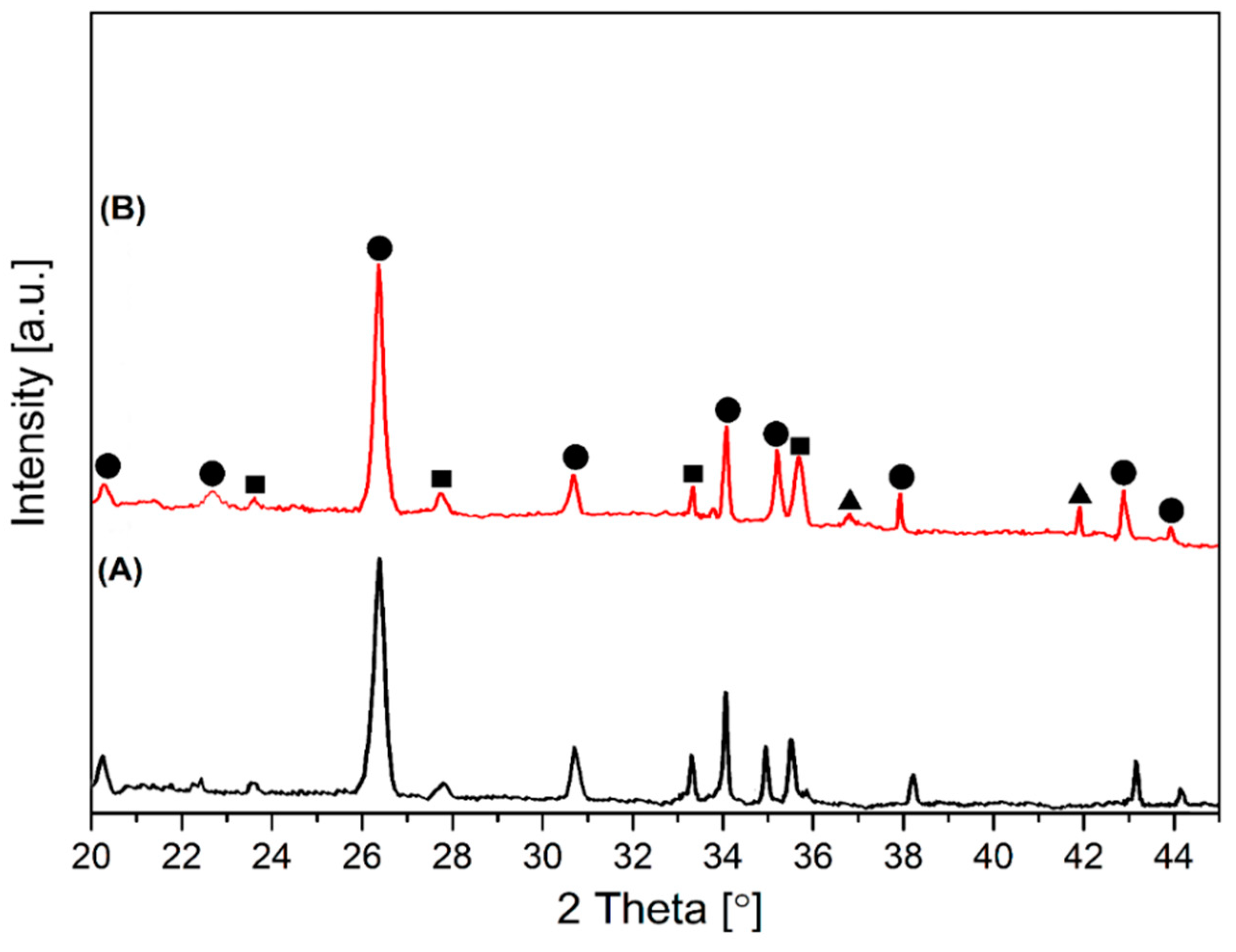

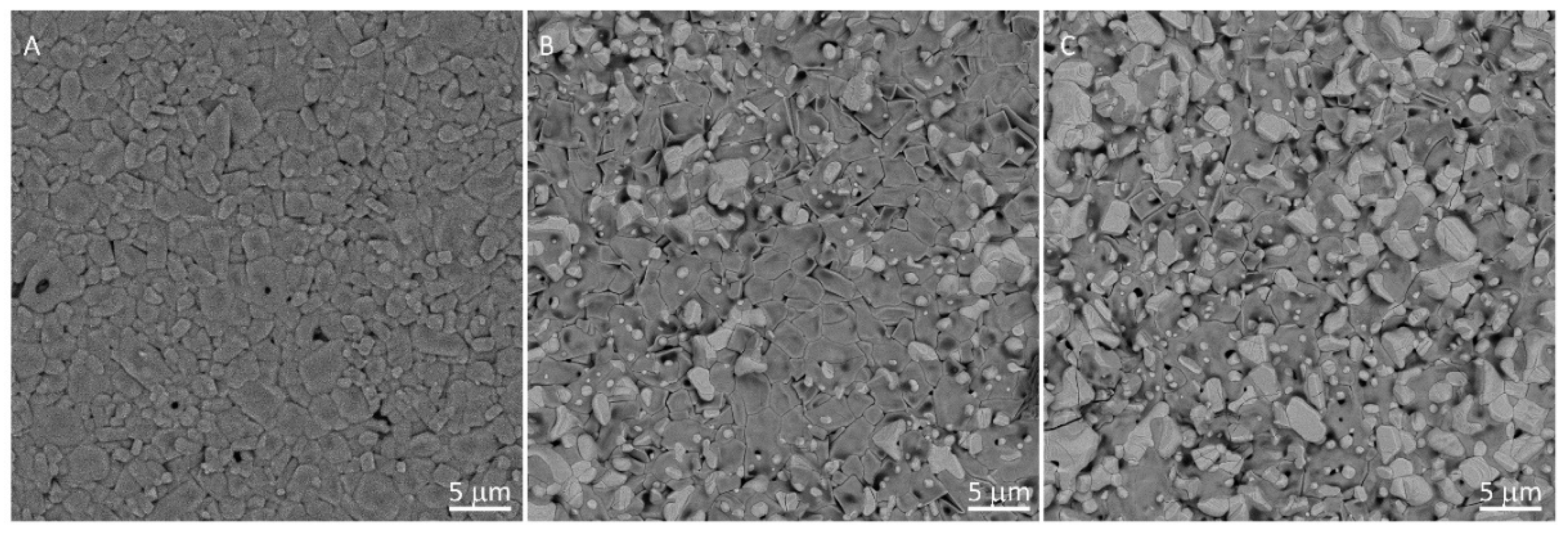
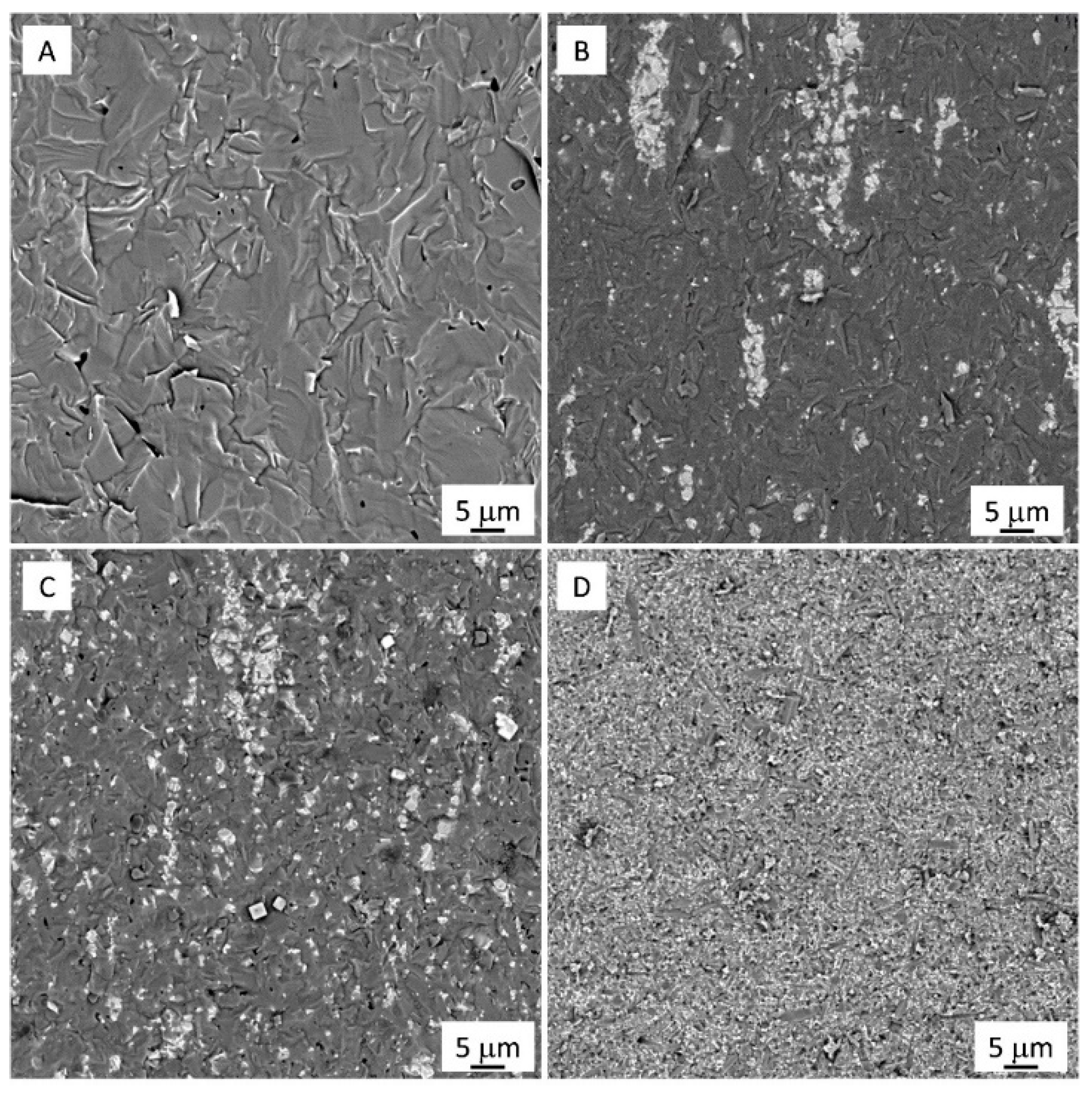

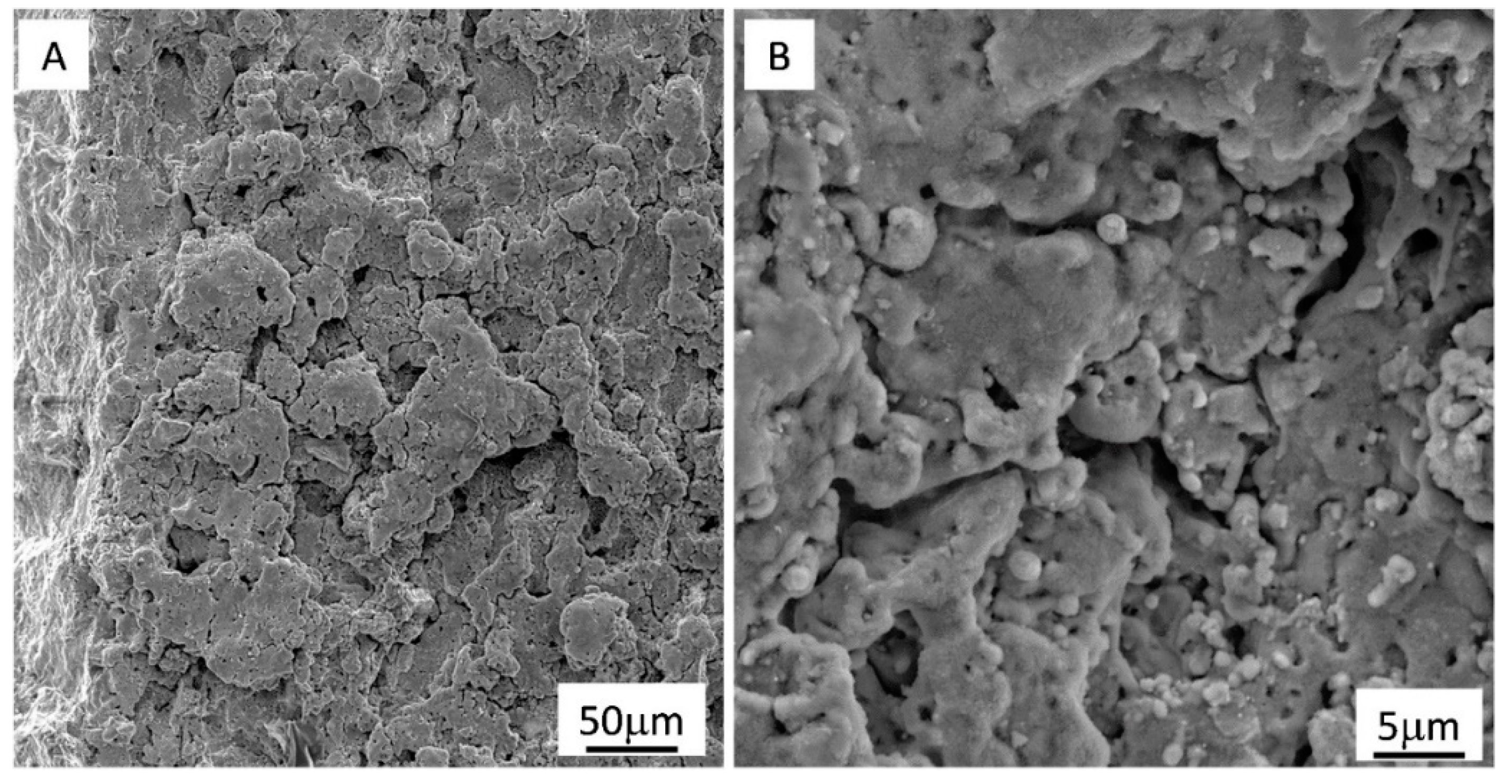

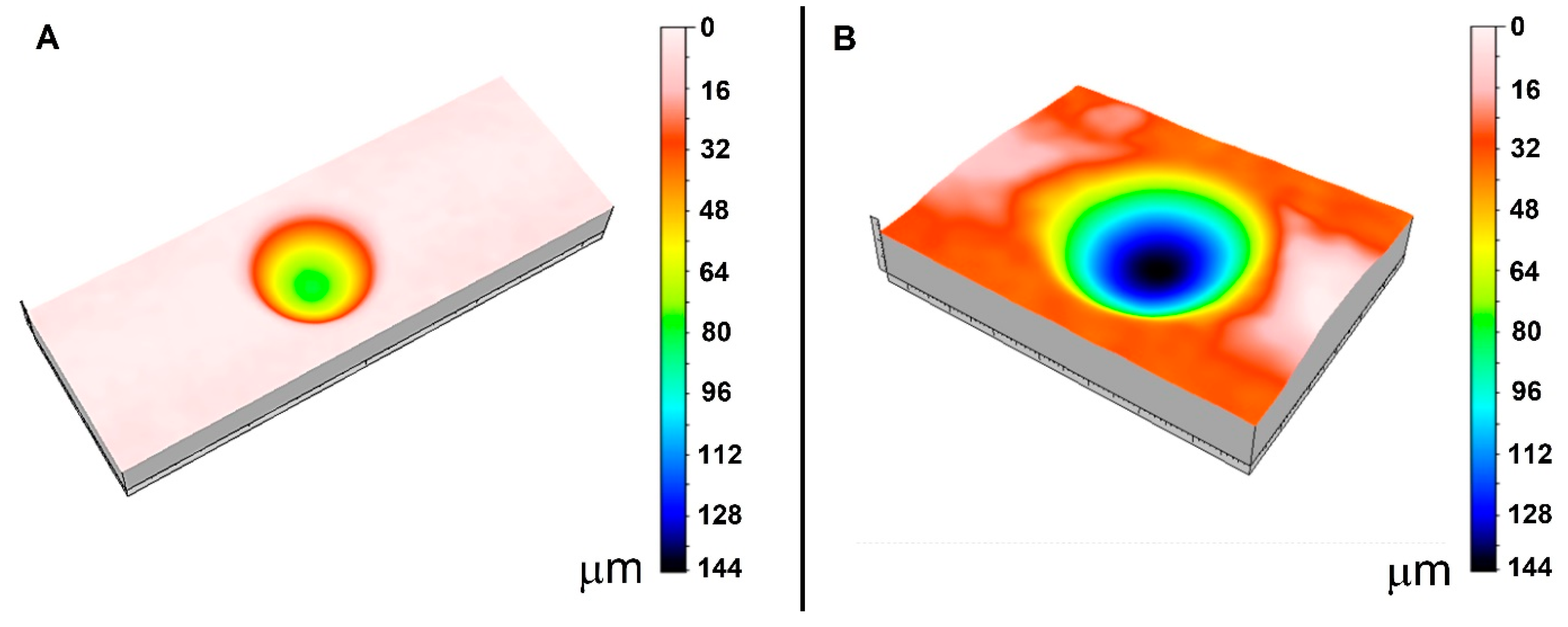
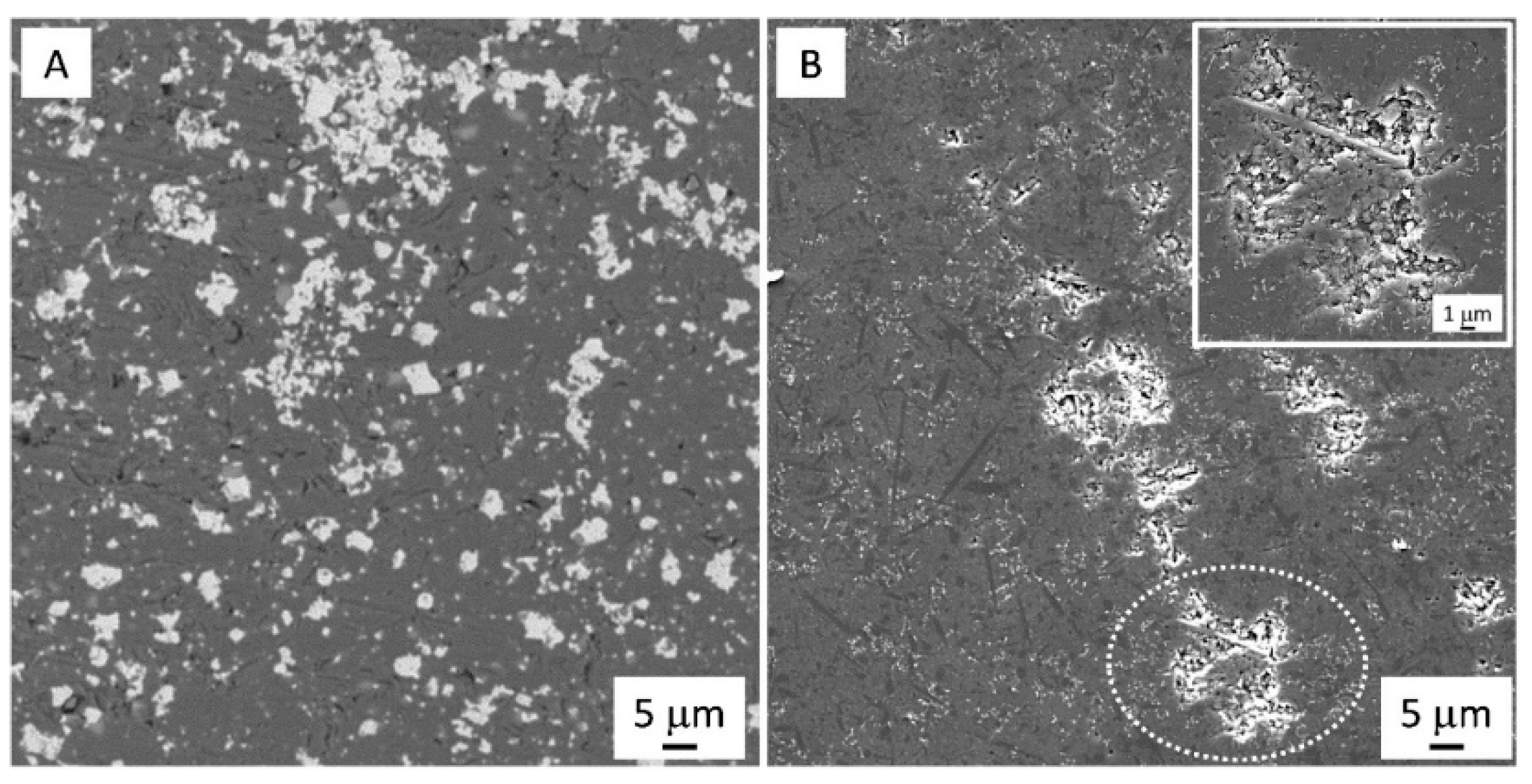
| Chemical Composition, % | ||||||
|---|---|---|---|---|---|---|
| C | Si | Mn | Cr | S | P | Fe |
| 1.00 | 0.25 | 0.35 | 1.50 | 0.008 | 0.025 | balance |
| α-β0T | α-β10T | α-β20T | ||||
|---|---|---|---|---|---|---|
| Density (g/cm3) | Density 1 (%ρth) | Density (g/cm3) | Density 1 (%ρth) | Density (g/cm3) | Density 1 (%ρth) | |
| 1600 °C | 3.20 | 97.7 | 3.39 | 97.3 | 3.92 | 97.1 |
| 1650 °C | 3.24 | 99 | 3.45 | 98.9 | 3.99 | 98.9 |
| 1700 °C | 3.27 | 99.8 | 3.48 | 99.7 | 4.02 | 99.7 |
| α-β0T | α-β10T | α-β20T | TC3030 | |
|---|---|---|---|---|
| Vickers hardness HV (GPa) | 14.4 ± 0.3 | 15.3 ± 0.4 | 15.9 ± 0.7 | 13.8 ± 0.3 |
| Toughness KIC (MPa∙m1/2) | 3.3 ± 0.3 | 4.1 ± 0.4 | 4.7 ± 0.5 | 3.4 ± 0.3 |
| Flexural strength σf (MPa) | 375 ± 9 | 343 ± 19 | 327 ± 26 | 360 ± 10 |
| Young modulus E (GPa) | 345 | 335 | 326 | 343 |
| Electrical resistivity (Ω∙m) | 1 × 1011 | 10.2 × 101 | 1.6 × 10−4 | 1 × 1011 |
Publisher’s Note: MDPI stays neutral with regard to jurisdictional claims in published maps and institutional affiliations. |
© 2021 by the authors. Licensee MDPI, Basel, Switzerland. This article is an open access article distributed under the terms and conditions of the Creative Commons Attribution (CC BY) license (http://creativecommons.org/licenses/by/4.0/).
Share and Cite
Grigoriev, S.; Pristinskiy, Y.; Volosova, M.; Fedorov, S.; Okunkova, A.; Peretyagin, P.; Smirnov, A. Wire Electrical Discharge Machining, Mechanical and Tribological Performance of TiN Reinforced Multiscale SiAlON Ceramic Composites Fabricated by Spark Plasma Sintering. Appl. Sci. 2021, 11, 657. https://doi.org/10.3390/app11020657
Grigoriev S, Pristinskiy Y, Volosova M, Fedorov S, Okunkova A, Peretyagin P, Smirnov A. Wire Electrical Discharge Machining, Mechanical and Tribological Performance of TiN Reinforced Multiscale SiAlON Ceramic Composites Fabricated by Spark Plasma Sintering. Applied Sciences. 2021; 11(2):657. https://doi.org/10.3390/app11020657
Chicago/Turabian StyleGrigoriev, Sergey, Yuri Pristinskiy, Marina Volosova, Sergey Fedorov, Anna Okunkova, Pavel Peretyagin, and Anton Smirnov. 2021. "Wire Electrical Discharge Machining, Mechanical and Tribological Performance of TiN Reinforced Multiscale SiAlON Ceramic Composites Fabricated by Spark Plasma Sintering" Applied Sciences 11, no. 2: 657. https://doi.org/10.3390/app11020657
APA StyleGrigoriev, S., Pristinskiy, Y., Volosova, M., Fedorov, S., Okunkova, A., Peretyagin, P., & Smirnov, A. (2021). Wire Electrical Discharge Machining, Mechanical and Tribological Performance of TiN Reinforced Multiscale SiAlON Ceramic Composites Fabricated by Spark Plasma Sintering. Applied Sciences, 11(2), 657. https://doi.org/10.3390/app11020657








